Vol 2 No. 27 TROPIC LIGHTNING NEWS July 10, 1967
Index
2nd Bde Nets 23 VC Ammo Caches
A Viet Cong rallier to the Government side recently led soldiers of
the 1st Bn., 27th Inf "Wolfhounds," to twelve arms and ammunition.caches in
two days of the 2nd Bde Operation "Kolekole." The finds were made in
the swampy lowlands between Duc Hoa and the Oriental River.
The rallier claimed he was a member of a local Viet Cong guerrilla
unit. He had given himself up to Vietnamese officials at Duc Hoa earlier
in the week.
MAJ Lynn Steversen, brigade intelligence officer, said that the
losses to the Viet Cong were critical and would be difficult to recoup. "The conditions in the monsoon season will make replacement of captured
material extremely difficult for the enemy," he said.
The first day Co B accompanied the rallier as he pointed out five
caches. They included: 8000 rounds of small arms ammunition, 60 Chinese
hand grenades, 32 rifle grenades, claymore mines, sub-machineguns, and 14 rounds
of RPG-2 anti-tank ammunition.
Through an interpreter, the rallier explained the usual method
local Viet Cong concealed their weapons. Though brigade officers did not
release details on the guerrilla technique, they did reveal that the following
day a U.S. unit using the method uncovered a cache of five PRC-10 military
radios near the Oriental River.
The same day, the rallier led Co C of the Wolfhound battalion to
seven more concealed storage sites. These included four rifles, one
Browning Automatic Rifle, one complete 60mm mortar, 112 hand grenades, 76 rifle
grenades, and a case of blasting caps.
In one 55 gal. drum the company found 45 sets of black pajamas, 60
hammocks made from sandbags, and 500 feet of electrical wire.
During the same period, brigade units destroyed 32 bunkers, seven
punji pits, six tunnels, and one unusable 20mm anti-aircraft cannon.
The action took place as part of Operation Kolekole, the 2nd
Bde's portion of the 25th Div's monsoon campaign.
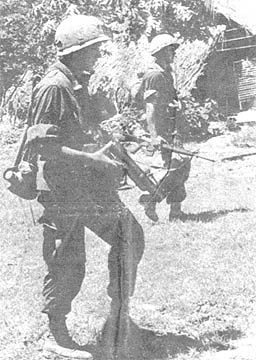 |
SP4 Gerald Dunham and SP4 Benny Raby of the 1st Bn, 27th Inf, advance into a village area as their unit takes part in a combat sweep southwest of Cu Chi. (Photo by PFC Bruce Dapprich) |
Camouflaged VC 'Bushes'
A 2nd Bde unit taking part in Operation "Kolekole" recently
killed 11 Viet Cong and supporting gunships killed 12 in an action west of Duc
Hoa.
Many of the enemy were so heavily camouflaged that soldiers of Co
A, 1st Bn, 27th Inf "Wolfhounds," described them as walking bushes.
The unit was moving through the swampy lowlands near the Oriental
River when the first contact was made. "I was acting as point man,"
said PFC Ronald Whited of Monroe, Mich., "when I spotted three bushes about
150 meters ahead that looked as if they were moving toward me."
Whited signaled the rest of the company and they quietly fell to
protective firing positions. The enemy moved to within 50 meters of the
hidden soldiers when they began firing.
The company, led by CPT Leonard Marcum of Lansing. Mich., returned
fire and began assaulting the enemy. "It was just like a charge you see
on television," said Whited.
Three Viet Cong were killed immediately, and their weapons were
captured.
More camouflaged enemy were spotted from the air by Battalion
Commander LTC Harvey Perritt. Elements of the 2nd Bn, 27th Inf., were
airlifted into blocking positions behind them and Co A continued their sweep
forward. Supporting helicopter gunships were called into the fight in
support of the "Wolfhound" units.
In the action that followed, Co A killed eight more, and captured
two M-1 carbines. 150 rounds of small arms ammunition and two sets of web
gear.
"We took them completely by surprise at first," said Marcum,
"everyone including the gunships did an outstanding job. Even the artillery
killed one VC without a shell being fired."
He referred to SGT James Allgood of Forest, Miss., the unit's
artillery forward observer. Allgood spotted a VC fleeing the battle site
and killed him with a round from his rifle. The enemy soldier was armed
with a Chinese assault rifle.
Helicopter Lost?
The flight control chief on duty at the 25th Avn Bn checks his
flight control board and discovers a helicopter pilot is late in reaching
Saigon.
Immediately he tries to reach the pilot by radio, but no answer.
Quickly he radios the other pilots in flight to see if they can reach him, but
no luck. Maybe he hasn't left Cu Chi. The chief makes a ramp
check. The word comes back that the pilot did leave.
The chief then radios Saigon, maybe due to a shift change the
report of the pilot's arrival was not made. But again no luck.
Saigon reports that the pilot has not landed.
The next move the chief makes is to call the artillery advisory
control stations along the pilot's flight route.
On each flight the pilot must radio ahead to each station to insure
that the artillery in the area is not firing so it is safe to pass over.
By radioing each one of these, the control chief will be able to
determine which station the pilot last radioed.
One by one the chief checks, finally he discovers that station
number three has not heard from the pilot. Something obviously has
happened to the pilot between station two and three. The control chief
checks air strips in that area to see if the pilot was forced to land.
The helicopter must be down between stations two and three.
Quickly the chief checks to see if any helicopters are left on the ground to
start a search and rescue mission, but none are left. He checks his flight
board and radios to pilots who are on routine missions to start the search and
rescue mission.
This is a fictitious situation, but the procedure is factual, and
in a real emergency the flight control chief of the 25th Avn Bn, 25th Inf Div,
can initiate a search and rescue mission in less than thirty minutes.
1st Brigade Monsoon Offensive Assists RVN Forces
Operation "Barking Sands" ranges from civic action to fierce
fighting for elements of the 1st Bde. The monsoon offensive was launched
May 15.
According to brigade commander COL Doniphan Carter, of Annidale,
Va., the overall objective of Barking Sands is, "to assist the Government (GVN)
forces in gaining the confidence and support of the local population. We
are also assisting in providing security and control for the Vietnamese people
in order to separate them physically and psychologically from the Viet Cong
military and political structure."
Carter added, "We are seeking to accomplish this by working
closely with the Government forces in flushing out and destroying the Viet Cong.
We are also supporting the GVN Revolutionary Development program."
The 1st Bde uses varied techniques, constantly looking for new
ideas. The pacification procedure presently includes seal and searches,
ambushes, psychological warfare projects and civil affair projects. These
projects include MEDCAPS, Helping Hand projects and aiding displaced personnel.
Food, clothing and other articles are distributed to the people.
The efforts of the Psychological and Civic Action teams have
destroyed the VC infrastructure in populated areas and the enemy's will to
resist. Civic Action sways the Vietnamese people away from the Viet Cong.
A MEDCAP's humane care of the sick and wounded is far more effective in
gaining the support of Vietnamese villagers than the VC tax collectors and
terrorists.
There has been a particularly high number of Viet Cong killed.
34 by actual body count and 35 possible. Another impressive figure in
operation Barking Sands is the number of caches discovered.
The never ending work of the infantryman has uncovered 130 punji
pits, 17 small arms, three machine guns, three recoilless rifles, 38 mortar
rounds, and 2656 rounds of small arms ammunition. The list continues with
67 anti-tank mines, 37 anti-personnel mines, 210 hand grenades, and 178 booby
traps. The men also confiscated 975 lbs of rice, 20 lbs of VC medical
supplies, 16 lbs of documents. 29 lbs of clothing, 18 sampans and 2 bicycles.
The Hoi Chanh who have turned themselves in have led the allies to
VC hideouts complete with equipment, food and more VC. One Hoi Chanh has
been most helpful in providing the allies with information on troop
concentrations, supply trails and other data that has proven surprisingly
reliable.
Air strikes have been a dominating feature in the operation.
Signs of the destruction and harassment caused by the air strikes are most
evident by the remains of 65 VC killed by the strikes and the terror expressed
by surviving VC. Artillery can claim much of this destruction and the VC
complain of its effectiveness.
Several successful RAG boat operations have taken place and one
unit has discovered huge VC tunnel complexes. The RAG boats are very
effective in patrolling shores and allowing our troops another avenue of attack.
This allows a blocking force to be situated along favorite VC retreat paths.
Operation Barking Sands hits the enemy from all angles. The
VC are losing ground in combat, losing irreplaceable supplies and are further
undermined by our winning the Vietnamese people to the Government side.
Page 2 TROPIC LIGHTNING NEWS July 10, 1967
Decorated
| SILVER STAR | |
|
COL Marvin D. Fuller, HHC, 2nd Bde, 25th I,nf Div CPT Emil C. Gregg, Co A, 3rd Bn, 21st Inf, 196th Lt Inf Bde 1LT Thomas L. Coldren, Co C, 1st Bn, 27th Inf SP4 Larry W. Gephart, Co A, 2nd Bn, 27th Inf |
SP4 Rex J. Kaufman, Co C, 2nd Bn, 27th Inf SP4 Richard M. Miller, Co C, 2nd Bn (Mech), 22nd Inf PFC Francis H. Good, Co B, 3rd Bn, 22nd Inf |
| DISTINGUISHED FLYING CROSS |
|
|
MAJ Donald J. Johnson, HHC 1LT Bruce A. Powell, Trp D, 3rd Sqdn, 4th Cav |
CWO Archie P. Fremen, 147th Asslt Spt Hel Co |
| BRONZE STAR (VALOR) |
|
|
MAJ Herman L. Sexton, HHC, 125th Sig Bn CPT Clyde A. Hennies, Co A, 4th Bn (Mech), 23rd Inf CPT Ronald W. Lind, Hq & Svc Btry, 2nd Bn, 77th Arty CPT John R. McCormick, HHT, 3rd Sqdn, 4th Cav CPT William B. Oakley, Co B, 125th Sig Bn CPT Walter M. Smith, Co B, 1st Bn, 27th Inf CPT George C. White III, Co C, 2nd Bn (Mech), 22nd Inf 1LT David H. Keege, Co C, 1st Bn, 27th Inf 1LT Donald A. Kyle,, Btry B, 2nd Bn, 77th Arty SGM Floyd N. Shaw, HHC, 125th Sig Bn SFC Marlin J. Goodhue, Co C, 1st Bn, 27th Inf SSG Edwin Convoy Jr, Co A, 2nd Bn, 14th Inf SSG Ernest Potter, Btry B, 2nd Bn, 77th Arty SGT James A. Brescia Jr, Co A, 1st Bn (Mech), 5th Inf SGT Michael R. Hobing, Btry B, 2nd Bn, 77th Arty SGT Clyde J. Silva, HH&S Btry, 2nd Bn, 77th Arty SGT Milburn R. Van Meter, HHC, 3rd Bn; 22nd Inf SP4 Carl R. Bailey Jr, Co A. 3rd Bn, 22nd Inf SP4 Thomas L. Hayden, Co. A, 1st Bn (Mech), 5th Inf'. SP4 James Howard, HHC, 1st Bn (Mech), 5th Inf SP4 Anthony Jones, Co A, 3rd Bn, 22nd Inf SP4 Terrance L. McCann, Btry B, 2nd Bn, 77th Arty SP4 Peter J. Nicolini, HHC, 1st Bn, 27th Inf |
SP4 Eugene V. Pacinella, Btry C, 2nd Bn, 77th Arty SP4 Patrick N. Peters, Btry B, 2nd Bn, 77th Arty SP4 Willie E. Russell, Btry A, 2nd Bn, 77th Arty SP4 Don B. Schulte, Co B, 3rd Bn, 22nd Inf SP4 James B. Stanley, HH&S Btry, 2nd Bn, 77th Arty SP4 Edwin L. Sutton, Btry A, 2nd Bn, 77th Arty SP4 Ricky D. Thorton, Co B, 3rd Bn, 22nd Inf SP4 Augustine Velasco, Co B, 3rd Bn, 22nd Inf SP4 Steven P. Walter, Btry B, 2nd Bn, 77th Arty SP4 Ronald W. Zecca, HH&S Btry, 2nd Bn, 77th Arty PFC Perry B. Adkins, Co A, 2nd Bn, 27th Inf PFC Robert T. Carnoske, Co A, 4th Bn, 9th Inf PFC Baxter H. Ellis, Co B, 3rd Bn, 22nd Inf PFC James L. Hatadis, Btry A, 2nd Bn, 77th Arty PFC Terry L. Jenkins, Co A, 2nd Bn, 27th Inf PFC Gerald F. McGinnis, Co A, 2nd Bn, 27th Inf PFC William D. McDaniel, Co A, 2nd Bn, 27th Inf PFC Andrew Moesch, HHC, 1st Bn (Mech), 5th Inf PFC Michael A. Persaiano, Btry A, 2nd Bn, 77th Arty PFC Arlo G. Saboe, Co C, 2nd Bn, 14th Inf PFC Herbert F. Tipton, Co A, 1st Bn (Mech), 5th Inf PFC Richard H. Watterson, Co B, 3rd Bn, 22nd Inf PFC Johnny Williams, Co B, 3rd Bn, 22nd Inf |
| ARMY COMMENDATION MEDAL (VALOR) |
|
|
MAJ Robert E. Stromfors, 25th MP Co |
SP5 Michael J. Russell, HHB, 25th Div Arty |
New Policy For Vietnam Promotions
Washington (ANF) - Chief of Staff GEN Harold K. Johnson has
approved a liberalized promotion policy in US Army, Vietnam, to permit
accelerated promotions to the grade of E-4, E-5 and E-6.
The new policy, based on recommendations from a Department of the
Army personnel survey team in Vietnam, was approved May 23 for the remainder of
May and the month of June.
The survey team recommended that DA take action to improve the
promotion situation for enlisted men in Vietnam, pending a full analysis of all
the recommendations by the team. The team returned from Vietnam on June 1.
The following promotion authority was given:
No limitation will be placed by DA on the number of in-country
promotions an enlisted man serving in USARV can receive if otherwise qualified.
Up to five percent of the authorized strength in USARV, up to three
percent of the authorized E-5 strength, and up to two percent of the authorized
E-6 strength may be promoted from the grade below without regard to
time-in-grade and time-in-service criteria.
The survey team found the old system did not permit sufficient
latitude for the promotion of outstanding personnel.
Editorial
dark ... damp as a prison cell
"It's up to every American to fight for the freedom we hold so
dear. If we don't, the smells of free air could become dark and damp as
in a prison cell."
This was written in a letter by Army PFC Hiram D. Strickland last
year which won the George Washington Award from the Freedoms Foundation.
PFC Strickland never received the award. It was presented to
his family because he was killed in Vietnam defending the freedoms he held so
dear.
This freedom for which so many have sacrificed their lives on the
battlefields of the world is the basis for the 1967 Freedoms Foundation Awards
Program. This year's subject is, "Freedom: My Heritage, My Responsibility."
Every serviceman and woman on active duty is eligible to submit as
many entries as he may desire. Each entry may be in the form of a letter,
essay or poem of not less than 100 nor more than 500 words in length.
Entries must be sent to Freedoms Foundation, Valley Forge, Pa., 19481, prior to
Nov. 1, 1967.
Members of the Armed Forces may also compete for the other Freedoms
Foundation awards offered. Dependents of service members, who are not
eligible to enter the Letter Awards Program, may compete for awards in other
categories.
Additional information on the Freedoms Foundation Awards Program,
may be obtained by writing to Freedoms Foundation, Valley Forge, Pa., 19481.
When you submit your entry, be sure to include your full name,
rank, service number, branch of service, organization, and home state address.
Loud, Clear No As VC Attempt To Join Ranks
Two Viet Cong guerillas tried to join the ranks of a 25th Inf Div
night patrol and failed because they weren't "standing tall."
As the 1st Bn, 27th Inf, patrol was setting up firing positions,
SSG Henry Ward of Mt. Pleasant, S.C., noticed two men, wearing steel helmets and
field gear, walking around apparently doing nothing.
"I called to them," Ward relates, "but all I got back was a
mumbled answer. Then I realized that I didn't have anyone in the squad
that short so I ordered them to halt."
The two broke and ran in opposite directions . . . one escaped but
the other was killed by a M-60 gunner.
Flying Standby? Without Form 1580, You Won't
When you head back to the states, among the other things you have
to do, make sure you obtain some Department of Defense Forms 1580. That is
the Military Standby Authorization for Commercial Air Traffic.
You MUST have this form if you want to fly half-price standby in
the states now. You should have AT LEAST five copies.
Also, make sure they have been properly signed. Many men wind
up at the airport with a place to go but no way to get there standby because
they either didn't get DD Form 1580 or didn't get it signed properly.
The TROPIC LIGHTNING NEWS is an authorized publication of the 25th Infantry Division. It is published weekly for all division units in the Republic of Vietnam by the Information Office, 25th Infantry Division, APO San Francisco 96225. Army News Features, Army Photo Features, Armed Forces Press Service and Armed Forces News Bureau material are used. Views and opinions expressed are not necessarily those of the Department of the Army. Printed in Tokyo, Japan, by Pacific Stars and Stripes.
MG John C. F. Tillson III . . . . . . . . Commanding General
MAJ Bernard S. Rhees . . . . . . . . . . Information Officer
CPT John P. Fortner . . . . . . . . . . . . Officer-in-Charge
SSG David G. Wilkinson . . . . . . . . NCOIC
SP4 Terry S. Richard . . . . . . . . . . . Editor
SP4 John R. Dittmann . . . . . . . . . . Editorial Assistant
Page 3 TROPIC LIGHTNING NEWS July 10, 1967
Army Photo Team Shoots MEDCAP
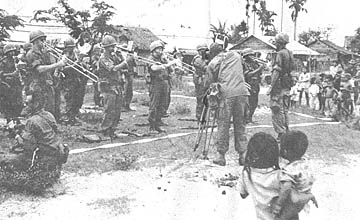 As the children laughed and the parents smiled
and accepted the medicine and soap, the cameras of a special Department of the
Army photographic detachment whirred.
As the children laughed and the parents smiled
and accepted the medicine and soap, the cameras of a special Department of the
Army photographic detachment whirred.
The "set" was the village of Bau Tram. The main
"actors" were the villagers with supportting roles played by the men of 2nd
Bn, 14th Inf. The plot was MEDCAP and the 25th Inf Div band played on.
The team, headed by "director" 2LT Richard Griffith of
Columbus, Ohio, works out of Ft. Shafter, Hawaii. Its mission is to
provide motion picture and still coverage of all Army activities in Vietnam.
The sets range from a village to the field and the plot goes from a
hot firefight to interviews. Many times the director has no control over
the action, but the show must go on.
The six man team spent more than a week with the 25th Inf Div
recording activities of the Tropic Lightning men.
The films are to be used at the staff level for evaluation of field
activities and for briefings.
Dragonmen Give To Repair Eyes
Tran Thi Goi and Nguyen Van Tao are two small Vietnamese children
who had been virtually blind for years. Both had glaucoma, an eye disease
that not only caused pain, but also detracted from their appearance.
Now, thanks to two soldiers, and the 12th Evac Hosp of the 25th Inf
Div, the youngsters' pain has been relieved and the disfiguring and sightless
eyes are soon to be replaced by artificial ones.
The children, Goi, 12, a girl, and Tao, 10, a boy, were brought to
a 2nd Bn, 14th.Inf, MEDCAP held at Ap Hoi Tham 30 kms northwest of Saigon by
their parents, who at the time were only seeking some way to relieve the
children's pain.
SP6 Blythe Tomlin, Franklin, Tenn., and PFC Raymond Weber, Jersey
City, N.J., took an interest in the youngsters' case, and directed them to the
MEDCAP doctor, who recommended the children be taken to the hospital for the
delicate operations they needed. The opthalmologist, CPT Roland Houle,
Boston, Mass., felt the operations were necessary not only to relieve the pain,
but also to prevent the possibility of tumors.
The right eye of each child was to be removed. However, the
parents could not afford the artificial eyes to take their place. Tomlin
and Weber offered to donate the necessary funds.
On the 23rd of June, Houle performed the operations, and said the
artificial eyes would be inserted in about six weeks. Further operations
on the remaining eyes will be necessary only if their condition worsens, which
is not expected in the near future.
Tao can see sunlight with his left eye and Goi has 50 percent
vision in hers. Unfortunately, extensive nerve damage prevented a cornea
transplant on their remaining eyes.
Ward nurse CPT Ellen Langston, Laconia, N.H., said, "the children
are doing fine, behaving well, and even playing a little. Their parents
visit them every day and have expressed gratitude for the compassionate
Americans who have made all this possible."
Phillip's Navy Now Sailing Waterways
The sampan glided silently down the canal, its occupants searching
the banks for enemy activity. Suddenly the men in the boat opened fire on
a soldier standing near the shore. The Viet Cong guerrilla fell dead,
another victim of "Phillip's Navy."
For some time Co C, 2nd Bn, 14th Inf, has been assembling a small
fleet of rubber boats and sampans. Some were acquired from Special Forces;
others were captured from the VC. Co C has been using their "navy" to
patrol the many small canals and waterways along the Saigon River during
Operation "Barking Sands."
CPT Frederick C. Phillips, Hot Springs, S. D., commanding officer,
says the boats enable his men to move quietly and unexpectedly through VC
territory, and this approach often gives them the element of surprise so
necessary in anti-guerrilla warfare.
LTC, PSG Charge VC Killing Two
By PFC Joe Carey
The first RPG-2 round fell fifteen meters short of its mark.
Platoon leader 2LT Charles Johnson ordered a right flank and assault. The
second round struck the engine compartment of the "command track." As
the crew was evacuating the vehicle a grenade landed and exploded on the open
hatch cover.
An element of the 3rd Sqdn, 4th Cav, was making a sweep of a
woodline in Binh Duong Province at the southern edge of the Thanh Dien Preserve
20 kms northeast of Cu Chi while on the 25th Inf Div's Operation "Barking
Sands."
LTC John M. Shea of North Springfield, Va., the squadron commander,
was riding on Johnson's armored personnel carrier at the time of the action.
Shea, armed with a .45 caliber pistol, dismounted and ran toward the hole from
which the grenade had been thrown. At the same time PSG Edward T. Gannon
of Columbus, Ga., was moving toward the enemy position. Shea crouched and
fired when a head appeared above the rim of the hole.
Deserves Credit
After throwing his only grenade into the hole, Shea returned to the
APC and grabbed an M-79 grenade launcher. Cannon in the meantime had also
thrown a grenade into the hole. Shea fired a rifle grenade into the
woodline and then emptied an M-16, found on the APC, into the enemy position.
Eight of the nine persons riding in the vehicle were wounded; only
Shea escaped injury.
After Hectic Night Wolfhounds Find All Was 'Ducky'
The eight-man outpost from Co A, 1st Bn, 27th Inf "Wolfhounds,"
spotted movement to their front soon after they took up their night position.
Intelligence reports had indicated that there was a Viet Cong unit in the area.
SP4 Michael Donohue of Salt Lake City was the first to notice the
movement. "We were with half the men on watch and half asleep. I
spotted what looked like heads bobbing up and down just as we were changing
over.
"The whole area was crisscrossed with rice paddy dikes, perfect
for the VC to sneak up on us," he said.
After that, no one slept. The movement was reported and the
men were told to keep watching, but not to fire unless attacked.
After a long nervous night, the tired soldiers moved cautiously
ahead. They found them behind a dike about 75 meters from their position.
"We sort of hate to admit it," said Donohue, "but it was a whole flock of
ducks moving back and forth along the dike."
The pressure off, the eight men walked back to the battalion base
laughing, but sure that it was better to be safe than sorry.
| MOBILE SANDBAGS - Take sandbags, one five ton truck, a .50 caliber machinegun and presto! A bunker on wheels. Constructed by the men of Btry B, 3rd Bn, 13th Arty, it proved its worth when it suppressed Viet Cong mortar fire near the village of Phu Hoa Dong on three successive nights. (Photo by PFC Richard Patterson) | 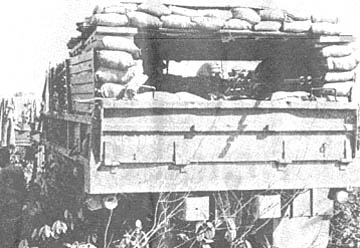 |
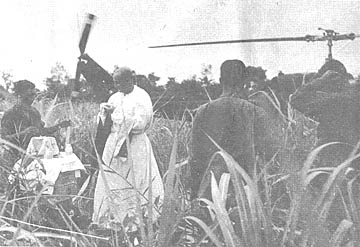 Chaplain
(Maj) James Peterman of Wilmington, Del., and his assistant, SP4 Joseph Zapata
of Brooklyn, N.Y., bring religious services to soldiers of the 2nd Bn., 14th
Inf., wherever they may be. Accoutrements are either in short supply or
nonexistent; altars and any other essential trappings are necessarily makeshift.
Chaplain
(Maj) James Peterman of Wilmington, Del., and his assistant, SP4 Joseph Zapata
of Brooklyn, N.Y., bring religious services to soldiers of the 2nd Bn., 14th
Inf., wherever they may be. Accoutrements are either in short supply or
nonexistent; altars and any other essential trappings are necessarily makeshift.
Traveling by helicopter, supply convoy, or on foot, Chaplain
Peterman manages to be where the troops are to provide moral and spiritual
guidance.
Zapata says, "The tired faces of the battle weary 25th Div
soldiers seem to light up when we come in." (Photo by SP4 Bill Wermine)
Page 4-5 TROPIC LIGHTNING NEWS July 10, 1967
From Mines and Trenches To Freer Travel
|
By 1LT A R Karel |
Duc Hoa and Bao Trai are the two most important villages in Hau
Nghia Province.
The first is the home of the 25th ARVN Div and the second is the
Province capital. For nearly ten years, Viet Cong mines and trenches have
made the road between them impassable. The bridge over a large stream just
north of Duc Hoa had been blown by VC terrorists.
Now all that is in the past and civilian and military vehicles
travel the route between the two villages regularly. The change, so
critical to the economy and defense of the heavily populated area, was brought
about by elements of the 2nd Bde, 25th Inf Div, as part of its Operation "Kolekole."
Kolekole is part of the 25th Div monsoon campaign. One of its
primary objectives, beside destruction of Viet Cong forces, is reconstruction of
major roads in the area.
The Duc Hoa-Bao Trai road was a road in name only. It bore
more resemblance to an obstacle course with trenches and mine craters that made
even foot traffic difficult.
The task of changing it fell to the 65th Engr Bn. The
unit's Co A began reconstruction at the north end and Co B started from the
south. The challenge given to units was to finish the project, bridge and
all, in two weeks.
The engineers trucked in gravel and laterite, filled the trenches,
graded them over and covered it all with a special water repellent chemical.
"Bravo" company attacked the problem of the blown bridge with a
gravel base, and a final fill of reinforced gravel and laterite. The two
companies caught sight of each other on the 12th day and finished the job on the
14th day, just as planned.
"The engineers were magnificent," said COL Marvin D. Fuller,
commander of the 2nd Bde. The brigade's 1st Bn (Mech), 5th Inf, provided
most of the security protection for the construction crews.
At a special ceremony held at the junction point of the road, MG
John C. F. Tillson III, told the hundreds of onlookers that this cooperative
effort between the Government of Vietnam and the 25th Inf Div would have a
profound effect on all their lives by increasing the security of the area and
allowing freer travel to area markets.
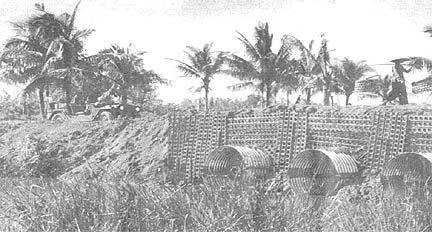 |
| 'This new bridge spanned one of the major holes in the road. It is capable of handling any vehicle. The culvert allows the stream to flow through without eroding the road. |
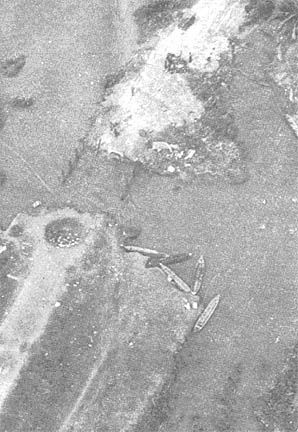 |
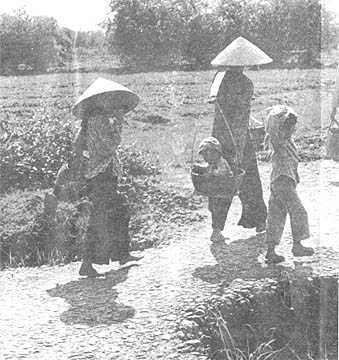 |
| Sampans were the only way across the bridge site blasted by Viet Cong terrorists. | A family of Vietnamese walk past a few of the hundreds of trenches dug by the Viet Cong to destroy the road. |
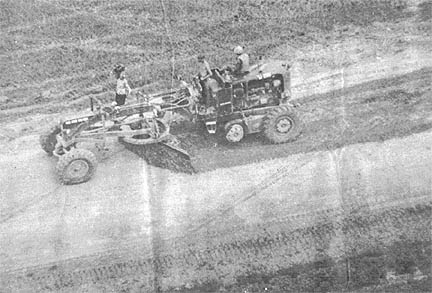 |
| The road surface is smoothed by engineer graders after the trenches and mine holes had been filled in. |
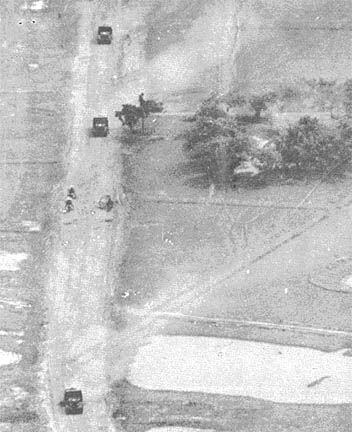 |
Trucks make use of the early sections of the road to haul in gravel for the bridge site. Four days earlier this section was impassable to all but foot traffic. |
Page 6 TROPIC LIGHTNING NEWS July 10, 1967
MEDCAPs To Villages Via Floating Doctor
CPT Don Harmon of Ochopee, Fla. packed himself, medical supplies,
clothing and a doctor-medic team into two tiny boats and headed across the muddy
Oriental River. He was about to bring medical care to a hamlet that
hadn't seen a doctor in nearly a year.
Harmon is Civil Affairs officer of the 1st Bn, 27th Inf
"Wolfhounds," part of the 25th Inf Div's 2nd Bde.
"There were no US troops operating in the area but we felt the
need was great enough to make the trip," said Harmon.
Villagers welcomed the three-man team as they pulled into the far
shore. Battalion surgeon CPT Ted Ammel set up his medical station while
Harmon distributed clothing, soap, and magazines explaining the Allied cause and
showing the latest in US-ARVN cooperative projects.
By late afternoon the team had treated 85 patients. As they
packed their medical gear back into the boats and pushed away from the shore,
many of the villagers waved them off. "Civil Affairs work, especially
MEDCAP, is very rewarding," said Harmon, "our only regret is that we can't
visit hamlets like this one more often."
25th Inf Div and Hawaii Helping Hand
Winning Battles in The Quiet War
It may be that wars are won with weapons; friends are not.
The "Helping Hand" extended to the people of South Vietnam by the people of
Hawaii through the 25th Inf Div is winning Asian friends for America.
"Tropic Lightning Helping Hand" is the name of the program
begun in Hawaii in January of 1966. Support for the program, which is
administered by the G-5, or Civil Affairs section of the division, was immediate
and encouraging. Governor John A. Burns met with MG Fred C. Weyand, then
commanding ganeral of the 25th Inf Div, to lend his full cooperation and
support. The Boy Scouts of America and the Aloha Council reached out their
hands also. And, most importantly, the people of Hawaii were quite
generous.
Donated materials (as well as those garnered from captured Viet
Cong caches) are stored at and distributed from the 25th base camp at Cu Chi.
A handful of soldiers from the division's G-5 section, along with
a number of Vietnamese workers, built the storage areas and daily prepare the
boxes (kits) to be distributed by units participating in the Medical Civic
Action Program (MEDCAP) or on military operations.
The basic kits include a refugee kit for families (a rice cooker,
fry pan, soup base, two water buckets, and cooking utensils), woodworking kit
(rip saw, cross cut saw, large claw hammer, plane, chisels, drill bits and
drill), school kit (notebooks, pencils, ruler, pens, chalk, erasers, slates, and
a plastic carrying bag), and a condolence kit (articles of clothing, toys,
shower shoes, bag of rice, health and sanitation items, canned goods, and a
leaflet explaining how to cook American food). Money was also donated
during the Helping Hand Campaign in Hawaii and has been used to supplement the
kits.
MAJ Loiuis S. Jennings, assistant G-5 officer, says the program has
difficulty in obtaining some items. Among these are school items such as
scissors, rulers, and slates; athletic equipment; and toothbrushes toothpaste,
towels, and soap (hotel-size). Hand tools are also in short supply.
On a typical combined MEDCAP and civic actions mission the
much-needed items are distributed in one of two manners. The material is
either handed over to the village chief or distributed through a series of
stations located near the village. In the latter instance the families
file by to receive their allotted portions. The civic actions group, which
works in conjunction with the village chief, is preceded through the village by
an ARVN psychological welfare team which explains what is about to happen; the
Vietnamese soldiers also cite the advantages of the Chieu Hoi Program.
More than 170,000 people have been reached by Helping Hand to date.
One thousand MEDCAPs have treated in excess of 106,000 patients.
'Quarter Million' R&R winner
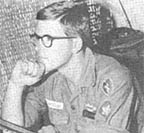 How would you like a ten day R&R with free hotel, food, gifts,
and as much publicity as a movie star? That's just what happened to SP4
Keith R. Hadfield, a former machinegunner turned awards clerk, from Co A, 2nd Bn, 27th Inf "Wolfhounds."
How would you like a ten day R&R with free hotel, food, gifts,
and as much publicity as a movie star? That's just what happened to SP4
Keith R. Hadfield, a former machinegunner turned awards clerk, from Co A, 2nd Bn, 27th Inf "Wolfhounds."
Hadfield was the 250,000th Vietnam assigned military man to go
through the R&R program.
Vietnam newspapers had been describing the fabulous time awaiting
the "Quarter Million" mark passenger for weeks, but Hadfield hadn't
noticed. "When I arrived at the R&R processing center they told us
that someone on our plane was going to be the one, and that's the first I
heard about it," he said.
"We all went to get haircuts and shoeshines to be ready for the
big celebration. All the time they were telling us all the things the
lucky man would receive."
When the group arrived at the airport, they were formed in a big
semicircle with an R&R official at a microphone in the center. Movie
cameras and press photographers crowded the area. The official, an Army
colonel, welcomed the men and began reading off information about the winner.
"After he mentioned that he was 175 lbs, a SP4, and from
Illinois, I started to get a little nervous. When he called my name all
the cameras swung around on me, and my knees just about buckled. I even
forgot to salute the colonel I was so nervous."
The ceremony was the beginning of a whirlwind five day escorted
tour through Bangkok, Thailand. "Everywhere I went there were cameramen
and reporters," he said, "it was an exciting schedule."
Hadfield received gifts of everything from expensive dancing Thai
dolls to a 144-piece bronze tableware setting.
"It was hard to believe it was all happening to me," he said.
"This is the sort of thing I always, thought happened to someone else."
After the first five hectic days the newsmen all left, and he was
given another five days to recuperate on his own.
At the end of the ten days he packed his bags and returned to Cu
Chi, minus all the fanfare. Hadfield is now back on his job at "Alpha"
company, and just like any other G.I. he wishes he were back on R&R.
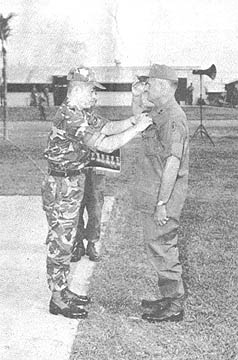 |
HONORED BY THE VIETNAMESE - MG John C. F. Tillson III, 25th Inf Div Commanding General, receives the Vietnamese National Order Medal, V Class, and the Cross of Gallantry with Palm, from GEN Cao Van Vien, National Defense Minister and Chief of the ARVN Joint General Staff. The ceremony took place during General Van Vien's visit to the division base camp at Cu Chi. (Photo by SP4 Jack Marz) |
Graduation Patrol Passes Finals Cum Laude
A squad of Viet Cong "guests" attended a pre-graduation
exercise at the 25th Inf Div four-day ambush and jungle tactics course.
An ambush patrol is the last phase of the course for the men before
returning to their units.
Second Lieutenant Aubrey Stacy of Melvere, Ark., was leading an
18-man patrol from an open field onto a road through a wooded area when the rear
security guard spotted two Viet Cong moving around behind them. Seconds
later an enemy squad hit the patrol with grenades and automatic rifle fire.
Stacy immediately set his patrol up in a triangle and returned the fire into the
enemy position.
The patrol then moved 50 meters off the road and SFC Joseph Newton
of Oneida, N.Y., radioed for 105mm artillery fire.
After the Viet Cong withdrew, Stacy moved the patrol back through
the woods. On the way back the patrol encountered several boobytrap wires
set at chest height.
Page 7 TROPIC LIGHTNING NEWS July 10, 1967
|
||||
| BATTLE ORDER - Air Force 1LT David McCracken, forward air controller from Pittsburgh, Pa., is followed by the camera as he directs a B-57 Canberra air strike from his tiny "Bird 'Dog" aircraft, against an enemy fortification 13 kms northeast of Cu Chi, in support of 25th Div infantrymen. From left: McCracken has sighted the target and calls for the B-57s; as the aircraft approach the area, he fires a smoke rocket to mark the target; A B-57 pulls up from a dive over the target; and the bomb explodes . . . on target. (Photos by MSG William Jackson) |
Nine VC Caught by FAC
A 1st Bde Foward Air Controller (FAC) "Bird Dog" directed an
air attack on at least 14 VC in mud near the Ho Bo Woods, 20 kms northwest of Cu
Chi.
Five VC were attempting to free a cart from the deep mud of a bomb
crater when a Bird Dog, piloted by MAJ Bogue Harrison of Downs, Kans., took
notice of their activity. Harrison said, "I spotted the cart with an
82mm mortar tube, tripod, and the works from 500 feet with binoculars. I
received fire almost immediately and the VC did not run as they usually do when
they see a FAC. In fact, nine more VC scurried to aid the cart pushers but
apparently to no avail.
By this time two gunships from the 25th Inf Div base camp saturated
the area with M-60 machinegun and rocket fire, chalking up several enemy
casualties. The VC returned the fire vigorously again, nicking one of the
gunships.
As the enemy was attempting to drag his wounded away, four
F-100's from Tan Son Nhut AFB laid several 750 pounds bombs on the position,
the finishing touches to a near perfect air assault. The jets also received
fire, but no damage to the F-100's was reported.
With the cart still stuck in the muck the Americans netted four VC
dead by body count and the remaining VC were listed as possibles.
One Man Wolfhound Squad Is Credited With 6 Kills
To the men of Co A, 2nd Bn, 27th Inf "Wolfhounds," acting SGT
Victor Padilla is like a one man squad. Padilla has accounted for six of
the company's last ten Viet Cong.
The 2nd Bde soldier accomplished the feat in a three week period of
Operation "Kolekole" southwest of the Cu Chi base camp.
On May 30th, Co A was on a search and destroy mission in the swamps
along the Oriental River west of Saigon, when one of the soldiers detected four
Viet Cong in a tunnel. As they surrounded the tunnel mouth a VC threw out
a grenade. Padilla grasped it and threw it away seconds before it
exploded. Then he rushed the entrance firing and throwing grenades.
A VC threw one grenade back out. Unable to reach it in time,
Padilla threw two other soldiers to the ground to protect them from the blast.
He received shrapnel wounds but again rushed the mouth, this time disabling the
enemy with smoke grenades.
Then, less than three weeks later, the company was pinned
down by heavy enemy fire soon after the beginning of a combat assault. Padilla
crawled ahead 30 meters under fire, jumped up, and charged a Viet Cong weapons
position. He killed two VC and completely destroyed the position.
A second enemy position drew the attention of the "one man
squad." He rushed across a canal, and killed two more VC with grenades
and rifle fire. The position contained several pounds of Viet Cong
documents.
PFC Becomes A Loner But Not By Own Choice
"I was all alone on the hot landing zone," said PFC Thomas
McGilvary. "I turned around and no one was there. The helicopters were
thirty feet above me and still going up."
McGilvary, a radio operator with the 3rd Pit of Co A, 2nd Bn, 27th
Inf "Wolfhounds," was taking part in a combat assault on a suspected Viet
Cong troop concentration 32kms southwest of Cu Chi.
"The choppers began taking enemy sniper fire as soon as we came
near the LZ," said McGilvary, "they all came to a hover about ten feet off
the ground so I figured this time they wouldn't go all the way down."
"I felt a nudge from my platoon leader so I jumped out and began
charging the hedgerow. Then I realized there was no one with me."
The helicopters had been ordered to another landing zone at the
last minute. The pilot finally realized he was short one passenger when he
was about sixty feet up and immediately swung around to pick up the "one man
assault."
Fact: Calm Water May Prove To Be Well-Deep
When you're slogging through a waist deep rice paddy, don't try
crossing the calm spot in the center. That's the advice of PFC Lawrence
Reyman, a rifleman with Co C, 2nd Bn, 27th Inf "Wolfhounds."
Reyman was on a combat sweep, part of the 2nd Bde's Operation
"Kolekole," when his unit came to the paddies. "I saw the clear spot
but I didn't think anything of it," he said.
One step later Reyman was doing the dog paddle for all he was worth
in a 20 foot deep irrigation well. In the swim back to shore he dropped
his rifle and steel helmet.
The "Wolfhound" company watched as Reyman removed his dripping
field gear and dove for lost equipment. "I had a little trouble finding
it," he said, "but the swim sure felt good."
The sweep continued with one very wet soldier keeping a sharp eye
out for clear spots.
Manchus Delay Supper With Results
A VC dinner table complete with steaming rice and freshly cooked
chicken led Co A of the "Manchus" to a hot but successful fire fight.
The Tropic Lightning troopers came across the food while on a sweep
32 kms northwest of Cu Chi. Only a hundred meters from Co A of 4th Bn, 9th
Inf, one VC was spotted running westward from the meal toward a heavy woodline.
The men opened fire and the VC dropped.
After the brief fire fight, the 25th Inf. Div soldiers came under
heavy sniper fire. Gunships were called in and raked the enemy positions
with machinegun fire.
| What Sort Of Man Reads
TLN? SP4 Carl Parker from Lake Charles, La. is constantly amazed at how many things can go wrong with one small helicopter. He is crew chief of an H-23 Light Observation Helicopter for the 2nd Bde Avn section, and it's his job to make sure all those things are fixed. After ten weeks of intensive schooling on the "bird" at Ft. Rucker, Ala., Parker began his tour in Vietnam. Could he fly the ship if he had to? Parker explained, "I've worked on it for the last nine months and know it inside and out. I could probably fly one, but it would really have to be a crisis." |
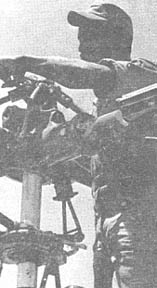 |
Page 8 TROPIC LIGHTNING NEWS July 10, 1967
Radar Keeps Watch
Recently two soldiers operating a "silent sentry" radar set
spotted six guerrillas about 600 meters in front of their bunker line.
When the guerrillas moved in close, the bunker guards opened up on them, driving
them off. The next day a reconnaissance patrol discovered patches of
blood, indicating the Viet Cong had suffered casualties.
At the time of discovery, visibility was very poor. It was
drizzling slightly and there was no moon.
Every night two radar teams are sent to guard forward fire support
bases, while two teams remain in the 25th Inf Div base camp. Each team
that is left in camp is responsible for a sector of the perimeter. They
have the advantage of being able to see more and further than the men in the
observation posts and night ambush patrols.
For example, they are able to pinpoint vehicle and troop movement
with great accuracy. They are also able to make fine distinctions as to
what is moving. They are able to detect the differences between such
things as water buffaloes and oxcarts.
"The VC know that there is something watching them, and since my
radar teams have been in operation, VC probing actions at the Cu Chi base camp
and the fire support base have been reduced greatly," remarked radar section
leader SSG Edward Horner of Appalachia, Va., who is the radar section leader.
"The Viet Cong are beginning to learn that even though they may
be in an area that is a great distance from the perimeter, where there are no
troops, he can be hit suddenly by accurate mortar or artillery fire," added
Horner.
"My equipment is very versatile, it is light, waterproof and very
durable. This is so necessary for the humid weather here. As the
equipment is operated in the field it must be able to withstand dust, mud, wind,
and rain," stressed Horner.
Horner later remarked, "It is remarkable how maintenance free my
equipment is, it enables me to better utilize my men.
"This contributes to the very high moral of my men. They
know that they can do a much more effective job if their equipment is
working," concluded Horner.
PFC Jerol F. Burr of Chicago, Ill., who has recently been assigned
to the radar unit, stated, "My job as a radar operator is real challenge and a
great responsibility. We have to be constantly alert while on the set."
This alertness, responsibility and challenge symbolizes the aims
and the operation of the radar units. It allows them to complete their
mission of providing early warning for the men of the base camp.
Boi Loi Bath
Two Viet Cong soldiers had their Saturday bath rudely interrupted
recently when they were spotted in a water-filled bomb crater near the Boi Loi
Woods northwest of the 25th Inf Div base camp.
The frolicking bathers were having such a good time that they
failed to see a 25th Avn Bn "(Huey)" helicopter hovering high overhead.
Co-pilot WO Randy Cartier, Baltimore, Md., dropped the chopper down
for a closer look. When the VC finally saw the Huey, they first tried to
play possum, then decided to go for their weapons. Pilot CWO Phil Timlin,
Eaton Rapids, Mich., gave the order to fire, and the helicopter's door gunners
opened up with their machine guns, killing both VC.
SP4 Richard Oglesby, Oakland, Calif., one of the gunners, said that
these two VC made a total of 18 confirmed enemy killed by the "Little Bears"
this month.
Steel Pot
Texan's Pot Shot
CPT Brian Loy of Houston, Tex., had seen a lot of Texas trick shot
acts where things were shot out of people's hands, but he never thought he'd
be a part of one.
Loy, the artillery liaison officer for the 1st Bn, 27th Inf
"Wolfhounds," had just finished a conference with the battalion commander at
the night combat base.
"I was lifting my steel pot to put it on my head when a burst of
machinegun fire from a Viet Cong sniper blasted it out of my hands," said Loy.
Everyone in the conference hit the ground and no one was hurt. Returning
fire silenced the sniper.
Stealthy Snake Trapped
An elusive snake, slithering around the controls of a helicopter,
prompted a 25th Div aircraft commander to radio in that as far as he was
concerned, his aircraft should be grounded.
While flying a mission for the 25th Avn Bn, CPT Thomas Fickle of
Meeker, Colo., felt a snake crawling across his right foot. Pilot WO George
Harrison of La Grande, Ore., took over the controls allowing Fickle to rid
himself of the snake.
Moments later Fickle regained the controls of the aircraft, because
it was Harrison's turn to chase the four-foot long snake from his feet.
As the aircraft neared Ben Hoa, the snake "broke contact" by
slithering under the floor plates. After landing, the crew removed all the
inspection plates from the fuselage, found the snake, but couldn't reach it
because of all the small compartments.
Fickle resumed the flight, and while over Long Binh, the snake
reappeared by poking its head out of an opening in the left door.
At this point Fickle radioed to battalion operations stating, as
far as I'm concerned this aircraft is down," and immediately returned to the
Cu Chi Airfield, where they picked up another helicopter.
Ground crew personnel worked four hours with tools, aerosol sprays,
and fire extinguishers before capturing and destroying the snake.
| BEATEN BANANA SNAKE - PFC Donald Hogan of Jamaica, N.Y., holds the elusive banana snake that prompted Aircraft Commander CPT Thomas Fickle of Meeker, Colo., to temporarily down his aircraft. It was not known whether the snake was poisonous but at the time nobody wanted to take any unnecessary chances. (US Army Photo) | 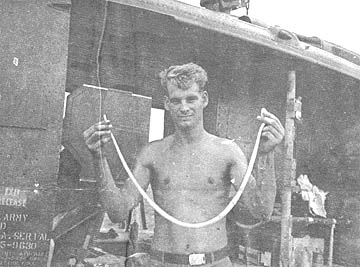 |
II Field Force
II FFV Commands III Corps Area
LONG BINH - On March 15, 1966, II Field Force Vietnam was
established as a tactical
headquarters controlling all combat units of the Free World Forces in the
Vietnamese III Corps Tactical Zone.
During its first year in Vietnam, II Field Force conducted four
multi-division operations: "Attleboro, Cedar Falls, Junction City" and
"Manhattan."
It is a lineal descendant of the X.XII US Army Corps, which was
activated in January 1944. During the latter stages of World War II, the
Corps earned two battle streamers for participation in the campaigns of the
Rhineland and Central Europe. At the close of World War II, the XXII Corps
was inactivated.
In January 1966, at Fort Hood, Texas, the Corps was reactivated and
the name changed to II Field Force.
Since its organization on March 15, 1966, II FFORCEV has assumed
operational control of the following major combat units: 1st Australian Task
Force, 1st Inf Div, 3d Bde of the 4th Inf. Div, the 9th Inf Div, the 11th
Armored Cav Reg, the 173d Abn Bde, the 196th Lt Inf Bde, the 199th Lt Inf Bde,
the 25th Inf Div, the 23d and 54th Arty Grps, the 12th Avn Grp, and the 2nd Bn
of the 34th Armor.
The 10,000-square mile area includes 231 miles of border with
Cambodia and 137 miles of coast line on the South China Sea.
The elevation varies from 0 to 5,000 feet and physical features
include mangrove swamps, flooded rice paddies, flat land, heavy tree-canopied
jungle to heavy jungle-covered mountains.
The mission of II FFORCEV is to conduct military operations in support of the
Republic of Vietnam in this vast area of geographical contrasts.
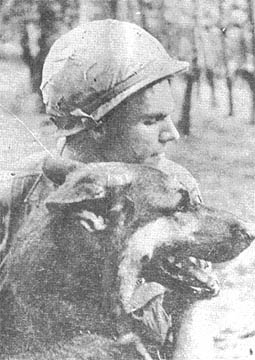 |
MAN'S BEST FRIEND - SP4 Frederick DeBarros and his scout dog Bo, members of the 44th Inf Scout Dog Plt, attached to the 3rd Bde, 4th Inf, prepare to move out on a search and clear operation through villages in the Michelin Rubber Plantation. (Photo by SP4 Brant Olds) |
Thanks to
First Sergeant O.N. Davisson, 25th Aviation Bn. for sharing this issue,
Ron Leonard, 25th Aviation Bn. for locating and mailing the issue,
Kirk Ramsey, 2nd Bn., 14th Inf. for creating this page.
This page last modified 8-12-2004
©2004 25th Infantry Division Association. All rights reserved.